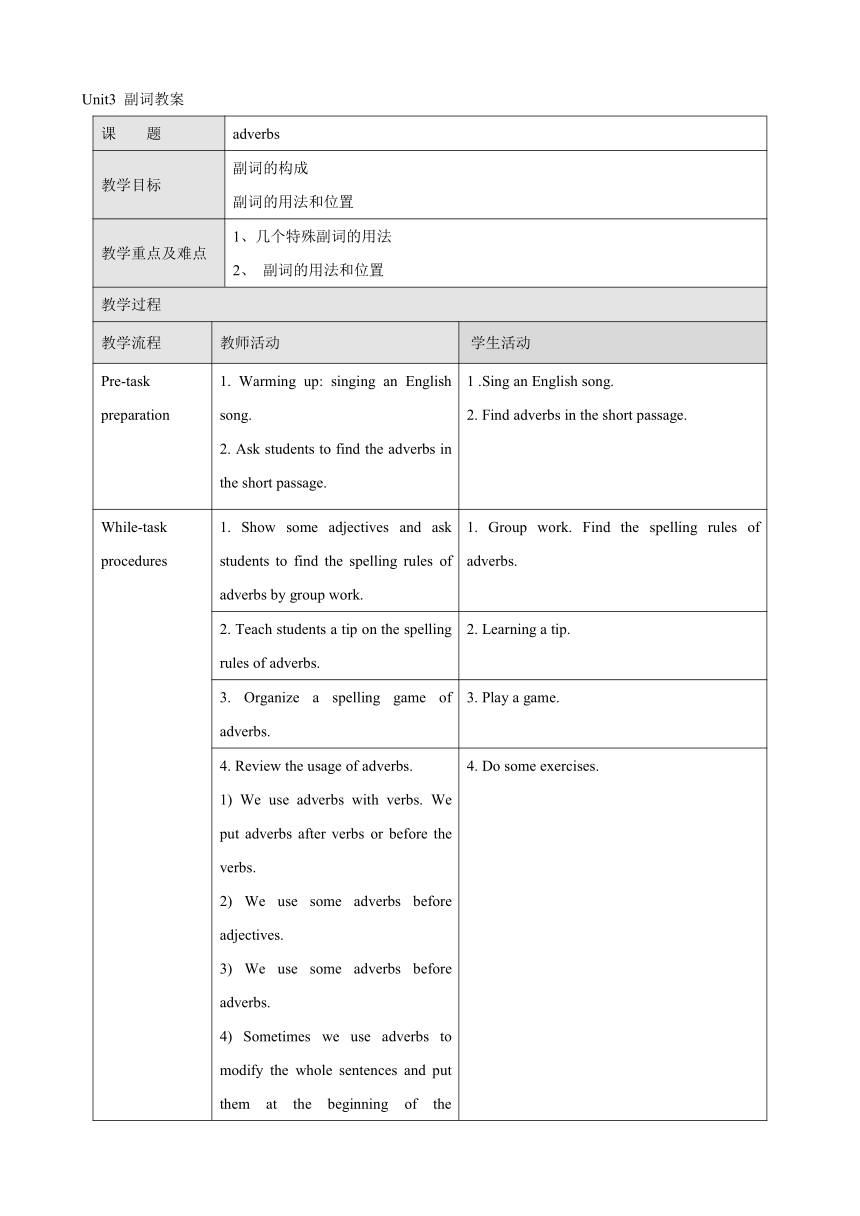Module1 Unit 3 Pets副词教案
文档属性
| 名称 | Module1 Unit 3 Pets副词教案 |  | |
| 格式 | zip | ||
| 文件大小 | 117.7KB | ||
| 资源类型 | 教案 | ||
| 版本资源 | 牛津上海版(试用本) | ||
| 科目 | 英语 | ||
| 更新时间 | 2017-09-14 22:28:14 | ||
图片预览

文档简介
Unit3
副词教案
课
题
adverbs
教学目标
副词的构成副词的用法和位置
教学重点及难点
1、几个特殊副词的用法2、
副词的用法和位置
教学过程
教学流程
教师活动
学生活动
Pre-task
preparation
1.
Warming
up:
singing
an
English
song.2.
Ask
students
to
find
the
adverbs
in
the
short
passage.
1
.Sing
an
English
song.2.
Find
adverbs
in
the
short
passage.
While-task
procedures
1.
Show
some
adjectives
and
ask
students
to
find
the
spelling
rules
of
adverbs
by
group
work.
1.
Group
work.
Find
the
spelling
rules
of
adverbs.
2.
Teach
students
a
tip
on
the
spelling
rules
of
adverbs.
2.
Learning
a
tip.
3.
Organize
a
spelling
game
of
adverbs.
3.
Play
a
game.
4.
Review
the
usage
of
adverbs.1)
We
use
adverbs
with
verbs.
We
put
adverbs
after
verbs
or
before
the
verbs.2)
We
use
some
adverbs
before
adjectives.3)
We
use
some
adverbs
before
adverbs.4)
Sometimes
we
use
adverbs
to
modify
the
whole
sentences
and
put
them
at
the
beginning
of
the
sentences.
4.
Do
some
exercises.
5.
Ask
students
to
pay
attention
to
some
special
adverbs,
such
as
“hard,
hardly,
lovely,
friendly,
lonely,
likely,
never,
seldom,
rarely,
and
hardly.
5.
Do
some
exercises.
Post-task
activities
Written
exercises
Assignment
Go
over
the
lesson
through
notebook.Do
some
written
exercise.
板书设计
形容词变副词的规律口诀
一般直接加,“元e”去e加,“辅y”改i加,“le”结尾e改y。副词的位置和用法:动词前或后。形容词和副词前句首Pay
attention
tolate,
early,
straight,
fast,
hard,
good,
well,
hardly,
lovely,
friendly,
lonely,
likely,never,
seldom,
rarely,
and
hardly.
副词教案
课
题
adverbs
教学目标
副词的构成副词的用法和位置
教学重点及难点
1、几个特殊副词的用法2、
副词的用法和位置
教学过程
教学流程
教师活动
学生活动
Pre-task
preparation
1.
Warming
up:
singing
an
English
song.2.
Ask
students
to
find
the
adverbs
in
the
short
passage.
1
.Sing
an
English
song.2.
Find
adverbs
in
the
short
passage.
While-task
procedures
1.
Show
some
adjectives
and
ask
students
to
find
the
spelling
rules
of
adverbs
by
group
work.
1.
Group
work.
Find
the
spelling
rules
of
adverbs.
2.
Teach
students
a
tip
on
the
spelling
rules
of
adverbs.
2.
Learning
a
tip.
3.
Organize
a
spelling
game
of
adverbs.
3.
Play
a
game.
4.
Review
the
usage
of
adverbs.1)
We
use
adverbs
with
verbs.
We
put
adverbs
after
verbs
or
before
the
verbs.2)
We
use
some
adverbs
before
adjectives.3)
We
use
some
adverbs
before
adverbs.4)
Sometimes
we
use
adverbs
to
modify
the
whole
sentences
and
put
them
at
the
beginning
of
the
sentences.
4.
Do
some
exercises.
5.
Ask
students
to
pay
attention
to
some
special
adverbs,
such
as
“hard,
hardly,
lovely,
friendly,
lonely,
likely,
never,
seldom,
rarely,
and
hardly.
5.
Do
some
exercises.
Post-task
activities
Written
exercises
Assignment
Go
over
the
lesson
through
notebook.Do
some
written
exercise.
板书设计
形容词变副词的规律口诀
一般直接加,“元e”去e加,“辅y”改i加,“le”结尾e改y。副词的位置和用法:动词前或后。形容词和副词前句首Pay
attention
tolate,
early,
straight,
fast,
hard,
good,
well,
hardly,
lovely,
friendly,
lonely,
likely,never,
seldom,
rarely,
and
hardly.
